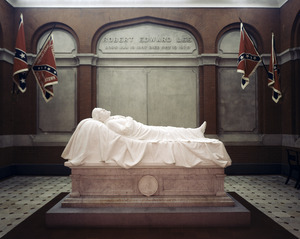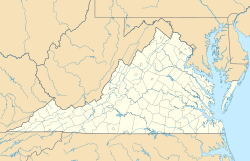University Chapel facts for kids
|
University Chapel of Washington and Lee University
|
|
|
U.S. National Historic Landmark District
Contributing Property |
|

University Chapel of Washington and Lee University (Lee Chapel)
|
|
| Location | Washington and Lee University campus, Lexington, Virginia |
|---|---|
| Built | 1867 |
| Architectural style | Romanesque Revival |
| Part of | Washington and Lee University Historic District (ID71001047) |
| NRHP reference No. | 66000914 |
Quick facts for kids Significant dates |
|
| Added to NRHP | October 15, 1966 |
| Designated NHL | December 19, 1960 |
| Designated NHLDCP | November 11, 1971 |
The University Chapel (once called Lee Chapel) is a special building at Washington and Lee University in Lexington, Virginia. It is recognized as a National Historic Landmark, which means it's an important place in American history.
This chapel was built between 1867 and 1868. It was requested by Robert E. Lee, who was the president of the school at that time. The university is partly named after him. The building's design, which looks like old Roman buildings, was likely created by Lee's son, George Washington Custis Lee. Other details were added by Col. Thomas Williamson, an engineering professor. When it was finished, during Robert E. Lee's lifetime, it was known as the College Chapel. Robert E. Lee was buried beneath the chapel in 1870.
Contents
The Statue of Robert E. Lee

Inside the chapel, in the main area where an altar might be in a church, there is a famous statue of Robert E. Lee. The statue shows him in his military uniform, appearing to be asleep on a battlefield from the American Civil War. This statue is called the "Recumbent Lee." It was created by a sculptor named Edward Virginius Valentine.
The "Recumbent Lee" statue was first shown to the public on June 28, 1883. It became the main feature of the chapel. It is often thought to be a tomb, but it is actually a statue resting on a base. Robert E. Lee is buried in a special room, called a crypt, underneath the chapel.
Inside the Chapel and Its History
On the walls of the chapel, near the statue, you can see two paintings. One is a portrait of President George Washington from 1796. The other is a painting of Robert E. Lee from 1866. These paintings were updated in 2018 to show how each person was connected to the school during their time. There is also a plaque that honors two students who died in World War I.
In the basement of the chapel, there is a crypt. This crypt was added after Lee's burial. It holds the remains of many members of Lee's family. This includes Lee himself, his wife Mary Anna Custis Lee, their seven children, and his parents. His father was Henry "Light-Horse Harry" Lee, a Major-General in the American Revolutionary War.
Just outside the chapel, Lee's favorite horse, Traveller, is buried. Many visitors leave coins, apples, or other small gifts there to remember him. The basement also has a museum. This museum tells the story of the families of George Washington and Robert E. Lee. It also shares the history of the university itself. Robert E. Lee's office has been carefully kept almost exactly as it was when he passed away.
The chapel is still used by Washington and Lee University today. It can seat about 600 people. New students gather there to learn about the school's Honor System. Important lectures, concerts, and other events are also held in the chapel. For many years, a special event for a national honor society called Omicron Delta Kappa (ODK) was held there. This event often took place around Robert E. Lee's birthday, January 19.
Recent Changes to the Chapel
Over the past few years, some changes have been made at the chapel. In 2014, flags that were around the Lee statue were removed after students asked for them to be taken down. Since 2018, large doors are often closed in front of the statue during university events. This helps to separate the statue area from the main hall. The goal is to make the chapel a welcoming place for everyone in the university community.
On June 4, 2021, the university's leaders officially changed the name of the building from Lee Chapel to University Chapel. The university also stopped celebrating "Founders Day," which was a holiday held on Robert E. Lee's birthday. The university plans to redesign and renovate the chapel. These changes will help to separate the main auditorium from the Lee family crypt and the Lee memorial statue.
University Chapel, when it was known as Lee Chapel, was named a National Historic Landmark in 1960. The famous writer Ralph Ellison was the first African American to speak there in 1963. Currently, there are no public tours scheduled for the chapel.
See also



